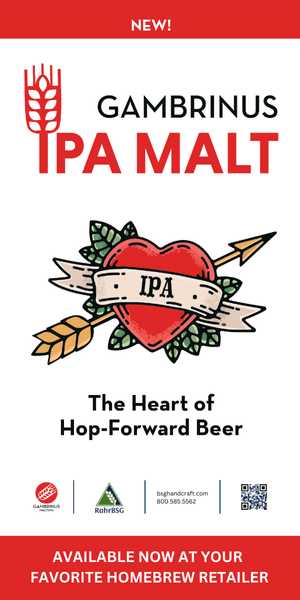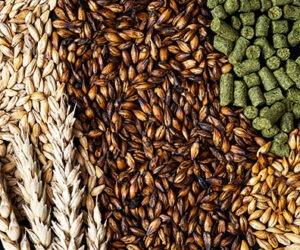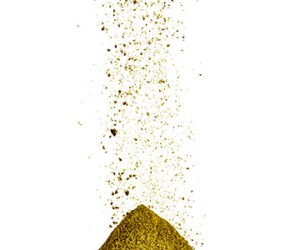Brewing with Apples
Just as cooking with fresh seasonal produce enhances the flavors in food, the same is true of beer. Freshly harvested plants, from peaches to pecans, are leaps and bounds more flavorful and aromatic than most internationally sourced supermarket-bought produce, since very often those plants are bred for long voyages and picked before they’ve fully developed. To put it in beer terms, would you prefer to brew a beer with a hop that was picked before it was ready and shipped under unknown temperature conditions for an unspecified period of time, or with a hop freshly picked off the bine from somewhere near your home? Flavor and aroma in any plant works exactly the same way it does in hops; picking, shipping, and seasonality will dramatically affect the quality of the beer you make.
Chances are, most people reading this have access to freshly picked ingredients from gardens or regional farms, even if they live in the middle of a big urban center. We are lucky to be living in a time in which people are finding their way back to the land—even if the land is stacked on a wall or planted on a rooftop garden—and farmers’ markets are proliferating. Nearly everyone is a walk, bus ride, car trip, or train stop from fresh, seasonal produce. Farmed plants are familiar to most people, but the idea of foraging may feel somewhat more foreign, particularly for anyone living in a city or suburb. Where do you start with foraging if you’ve never done it before? How do you know what’s safe and what’s toxic? How do you identify plants that look similar but have different, possibly poisonous effects? We have included a variety of foraged plants in our book, from the simplest and most easily identifiable to those that are slightly more difficult to identify and procure. A dandelion is a dandelion whether it grows in your front yard or in a field. You may not have thought twice about the juniper on your block in Phoenix, or the lavender that lines your sidewalk in Seattle, but they grow ubiquitously in many cities and suburbs, are easy to identify, and can all be used in beer.
We are located in the Midwest, so the ingredients in our recipes are biased toward this region; however, our home base of southern Illinois is a large area, almost equal in size to Connecticut, and lies between the Mississippi and the Ohio Rivers with Kentucky, Indiana, and Missouri on its borders—nestled between the heartland and the south. Its temperature and location make it one of the richest places for flora in the country, with biomes that overlap with many other parts of the United States. Some of the many communities that provide plant diversity here include moist ravines, ditches, swamps, marshes, streambeds, sandy riverbanks, hill prairies, rocky slopes, and sandstone and limestone ledges, springs, and caves.
Apple
Nothing is as emblematic of industrial farming as the Red Delicious apple. Marika remembers unsuccessfully attempting to trade away Red Delicious apples that her father had sliced and put into her lunch bag during elementary school. For a long time she refused to eat apples at all. That bitter red skin and often mealy interior — it’s certainly not a fruit to be kicked out of paradise over! The Red Delicious has been bred for over a hundred years for its color more than its flavor, as well as for the thick skin that allows it a longer shelf life. Thankfully consumer tastes changed in the late 1990s as new varieties, like Gala and Fuji, made their way to market and introduced refreshing flavors. Since then the Red Delicious has declined almost 40 percent in sales, and we’re seeing a resurgence in interest in new and old varieties of apples with full and diverse flavors — even if they don’t have that glossy lipstick exterior.
Southern Illinois orchards are filled with apples. Jonathon is a popular one: small and mottled red and yellow, it is sweet with a moderate punch of tartness. Pomona Winery, nested in the woods south of us, makes a beautiful dry Jonathon wine you could easily mistake for a grape wine. Jonathon is a variety that appears to have originated in New York State, most likely related to the Esopus Spitzenburg, an old variety thought to be a favorite of Thomas Jefferson. We have Esopus Spitzenburg in our garden, along with Honeycrisp, Cox’s Orange Pippin, and Grimes Golden — one of Aaron’s grandmother’s favorites. Together they would make a nice blend for cider. In fact, as anyone who makes cider will tell you, a good cider is a balance of several varieties of apples, selected for their tannins, tartness, and a wisp of their unique honey sweetness. The best ciders are often bone dry, can be relatively still or effusively effervescent, and sometimes even a little funky — descriptors often associated with Champagne and beer. The more you delve into the world of ciders, particularly from France or Spain, the more you’ll realize the overlap the apple has with some of the flavors we love most about beer. With the resurgence of heirloom fruits, some of the thousands of historical varieties of apples are now becoming available again, so you can experiment with a large number of apples to pick out your favorites for tartness, fruitiness, or tannin.
Beers we’ve made with apples at Scratch have been a celebration of these historical qualities, as well as a celebration of autumn. One of our recipes included here is an attempt to mimic the tartness of cider, while the other imparts a smoky flavor to caramelized apples to create a fall beer that has been one of our all-time favorites. Although our recipes all call for fresh apples, feel free to use the methods of preservation detailed later in this story to substitute dried apple rings or juice, and see how it affects the character of the beer.
Harvesting
When apples are ready to harvest, there are usually a lot to harvest. Fortunately, apples are also a great fruit to store and preserve. Certain varieties store better and longer than others, so it’s best to consult a guide with information about specific apple varieties. In general, if kept in a cool (but not freezing) place, picked over for worms or other spots, given good air circulation, and kept away from onions, potatoes, or pears, many apples will keep for a couple months and some as many as five months.
Dried apple rings are another great way to preserve the harvest and can make an excellent addition to beer. Slice thin and dry in a dehydrator.
Finally, the juice of the apples can be frozen and stored indefinitely. Juicing takes more time, but for brewing it can also be a big benefit, as it will impart more apple character and more fermentable sugar into the mix.
You may not think you have room for a fruit tree in your yard, but you will be rewarded if you decide to plant one. Apple trees take a few years to really produce, but one tree will give you enough apples for several batches of beer or 5 gallons (19 L) of cider. The flavor of your own apples from your own tree is also incomparable, like fresh tomatoes from your garden. If you have the space, it’s worth it.
Brewing
As with so many other plants, a bruised apple or one you would otherwise turn into applesauce because it’s only half edible is a perfect candidate for beer. Cut off the bad parts and you’re ready to go.
Like peaches, apple skins are also loaded with yeast and bacteria. We use a strategy for brewing with apples that’s similar to our approach with peaches. First, we don’t usually skin the apple — too much work. If the apples are going directly into the fermenter, we do submerge them in sanitizing solution to kill as much wild yeast and bacteria as possible. Very often we add fresh apples to the end of the boil to sterilize them. We seed them, quarter them, and chop them fine in a food processor to get as much surface area contact as possible. When making a sour beer, like the one included in the recipe on the next page, we are more game to put fresh apples into the fermenter. Note that most apples in this country are sprayed with some kind of pesticide, so it is very important to wash apples well before putting them into beer. Also, be sure to de-seed all apples since the seeds carry a compound that metabolizes into cyanide. Add 6 pounds of apples (2.7 kg) for a 5-gallon (19-L) batch.
We have also had great results puréeing the apples and cooking them for a long time, the same way one would make applesauce (see the first recipe below). This caramelizes the sugar in the apples and adds an extra layer of sweetness. We find little to no loss of apple character in the finished product, and this can go directly into the boil or fermenter without adverse effects from wild yeast and bacteria. We highly recommend this method for any apple addition, but especially for the smoked beer recipe below. For a 5-gallon (19-L) batch, puree 5 pounds (2.3 kg) of apples and cook down in a covered pot on medium until the apples fall apart and become brown and caramelized. Add a little water to the pot to keep the apples from burning.
Smoked Apple Ale
(5 gallons/19 L, all-grain)
OG = 1.055 FG = 1.011
IBU = 22 SRM = 7 ABV = 5.9%
A lightly smoked, hazy golden ale.
Ingredients
6.5 lbs. (3 kg) Vienna malt
2 lbs. (0.91 kg) wheat malt
1 lb. (0.45 kg) Munich malt
8 oz. (227 g) smoked malt
2 oz. (57 g) rice hulls
5 lbs. (2.27 kg) apples (puréed) (5 min.)
6 AAU Chinook hops (60 min.)
(0.5 oz./14 g at 12% alpha acids)
White Labs WLP005 (British Ale) or Wyeast 1098 (British Ale) yeast
¾ cup corn sugar (if priming)
Step by Step
Prior to the start of brewing, prepare the apples by coring them then puréeing them to a slurry. Simmer the purée down until the mixture has a consistency similar to applesauce. Crush the grains and mash in with 4 gallons (15 L) of water to hit 150 °F (66 °C). When conversion is complete, sparge with 5 gallons (19 L) of water at 168 °F (76 °C). Collect the wort and boil for 60 minutes. Add the hops at the beginning of the boil. Add the apples to the boil with 5 minutes remaining. Perform a 15-minute whirlpool at flameout.
Chill the wort to pitching temperature, transfer to the fermenter, and pitch the yeast. Ferment at
58 °F (14 °C) for two weeks. After two weeks, allow the temperature to rise to 70 °F (21 °C) until fermentation is complete. When fermentation is complete, bottle or keg as normal.
Tips for Success:
Our original recipe calls for an ounce of dried hickory leaves at the beginning of the boil. If you have hickory leaves near you, feel free to add them and reduce the hop addition by half to enhance the crisp fall flavor of this beer.
Sour Apple
(5 gallons/19 L, all-grain)
OG = 1.054 FG = 1.008
SRM = 6 ABV = 6.1%
A moderately tart sour ale with a hint of apple character.
Ingredients
8 lbs. (3.6 kg) Pilsner malt
2 lbs. (0.91 kg) Munich malt
6 lbs. (2.7 kg) apples (puréed) (5 min.)
White Labs WLP630 (Berliner Weisse Blend) or SouthYeast Labs
Wallahweisse (see step by step)
¾ cup corn sugar (if priming)
Step by Step
Prior to the start of brewing, prepare the apples by coring them, then puréeing them to a slurry. Simmer the purée down until the mixture has a consistency similar to applesauce. Crush the grains and mash in with 4 gallons (15 L) of water to hit 147 °F (64 °C). When conversion is complete, sparge with 5 gallons (19 L) of water at 168 °F (76 °C). Collect the wort and bring to a boil. Boil for 60 minutes, adding the apples with 5 minutes remaining. Perform a 15-minute whirlpool at flameout.
Chill the wort to pitching temperature, transfer to pitching temperature, and pitch the yeast.
We ferment this beer with our house sourdough culture, which is a mix of Saccharomyces and Lactobacillus. We pitch the culture at around 100 °F (38 °C) and hold it there for the first day, then let the temperature decrease naturally. Berliner Weisse blends from several of the major yeast suppliers would approximate our culture (see ingredients list for recommendations). Follow the yeast supplier’s guidelines. When fermentation is complete, bottle or keg.
Editor’s Note: This text is excerpted from the new book The Homeb
Photo courtesy of Scratch Brewing Co.
Marika Josephson, Aaron Kleidon, and Ryan Tockstein of Scratch Brewing Co. Scratch is a “farmhouse” brewery that focuses on local ingredients and was named one of the top four breweries for foraged beer by Outside Magazine.




